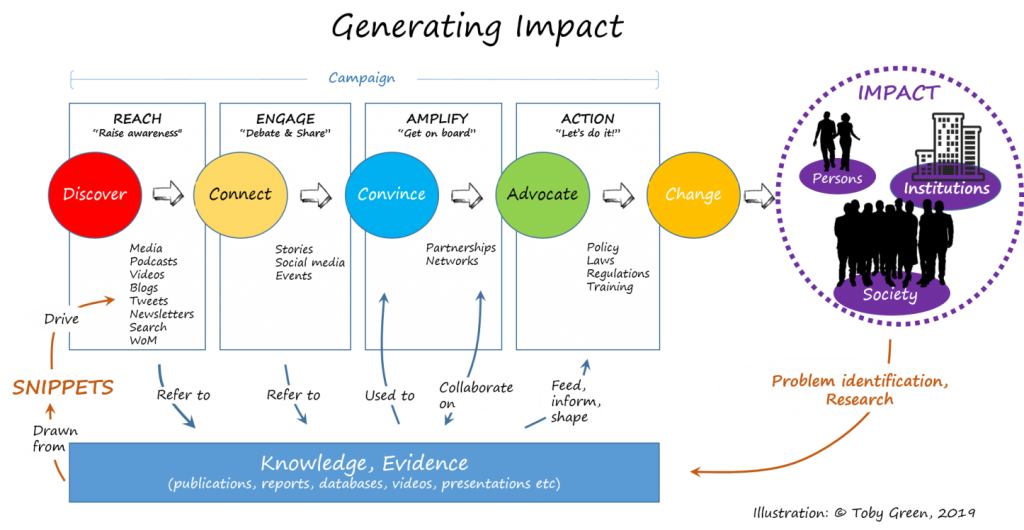Generating research impact with graphics

Why you should prioritise research impact and four reasons to use graphics to do so
Toby Green’s ‘Publication is not enough, to generate impact you need to campaign’ and Gemma Sou’s ‘Four reasons to graphically illustrate your research’ articles, both published on the London School of Economics blog this year, emphasise the importance of graphics and visuals in articulating your research and increasing the impact of your publications.
GEMMA SOU
Graphically illustrated research has expanded rapidly in academia.
Gemma shares “some of the reasons why graphic illustration can be a powerful and enlightening way to communicate your research”.
– Creating ethical public representations of your research
“Graphic novels, with their focus on character driven narratives, are able to communicate the rich lived experiences of all kinds of people to an outside audience. This can provide a more nuanced and ethical portrayal of your research and research participants.”
– Making your research more democratic
“There is something about the physicality and durability of a print graphic novella that lends both legitimacy and longevity to the research it presents. It won’t be lost somewhere in the wilds of the endless Internet, or trapped behind the pay wall of an academic journal, but can be found on a shelf for future generations to discover.”
– Teaching in engaging and innovative ways
“Graphic novels also offer new pedagogical avenues… they combine the power of ethnographic research, with the unique aesthetic elements… they build strong characters that drive the narrative without being too intrusive… readers can use their wider understanding of theories, concepts and ideas they have learnt in class, or elsewhere, to unpack the stories images, dialogue, and narratives”
– Releasing your inner creativity
“The graphic novella is also about providing opportunities for researchers to work more creatively themselves… researchers and graphic artists can share, push, pull, and compromise as necessary in the pursuit of a visual representation of research. This process has been challenging and exciting… it has raised questions about what to leave out, what works narratively and aesthetically, but also about how to ensure the integrity of the research and of those being represented.”

TOBY GREEN
So, what can you do to make your work more impactful?
One simple thing you can do, is to be graphic. Humans are visual and are 80% more likely to read a text when it has an image.
“Gemma Sou, writing in this blog, reported that employing graphics not only helped communicate her work, it transformed her research practice, making it more relevant. Learning how to reach your audience therefore is not just an addition to your research, it can also make your research better.”
Green tells us that “After reaching an audience, authors should develop their network to build campaigns that raise awareness, stimulate debate and convince others to get on board to advocate for change. It’s important not to simply send out an email blast, or push tweets out, but to engage with your intended audience over a period of time. This means listening to what your audience is saying in their presentations, tweets and blog posts and responding using snippets from your research findings so a conversation develops.”
“I can hear many of you now: “but I’m too busy to promote my papers”. Let’s put this in context. If you’ve spent many months – even years – gathering data, writing up the results and getting a paper through the publishing process, isn’t it worth spending time on making sure your findings reach beyond your immediate peer group? Otherwise, aren’t you just keeping the results to yourself? A ‘launch-and-leave’ approach (do some promotion when a paper is launched and then leave the scene hoping an audience will develop by itself) is highly unlikely to generate much impact and means you’re going to get a poor return on the investment you made in writing a paper in the first place. This doesn’t necessarily mean investing time promoting each and every paper, but it does mean thinking about a strategy to communicate the results of your research so they have the best chance of making an impact.”
“In this digital world, funders know that there’s a data trail to every online action and are coming to expect researchers to do more than just report on citations, they want to see the evidence that your findings escaped academia’s gravitational pull and are informing a broader audience of practitioners and policy makers. Researchers who are prepared to invest as much time in promoting their works as they did writing them, and can show the results, are not only going to be more visible and impactful, they’re likely to win more grants.”
“Persuading someone to take action, to change something, is hard and on its own the information contained in a paper is unlikely to do the job. You need to do more than just publish and hope – you need to be creative and active.” x

Learn more about Toby and Gemma’s work and strategies by reading the full blog posts.
Leave a Reply